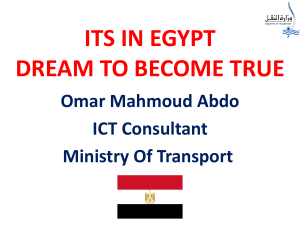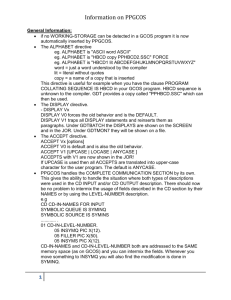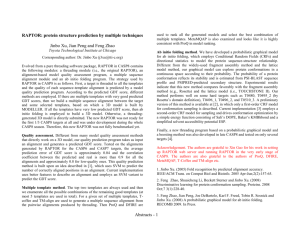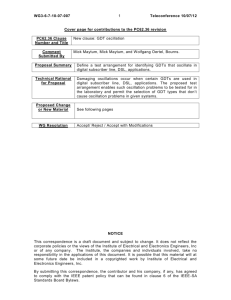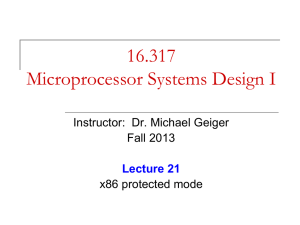Definition of Virtual Teams
advertisement
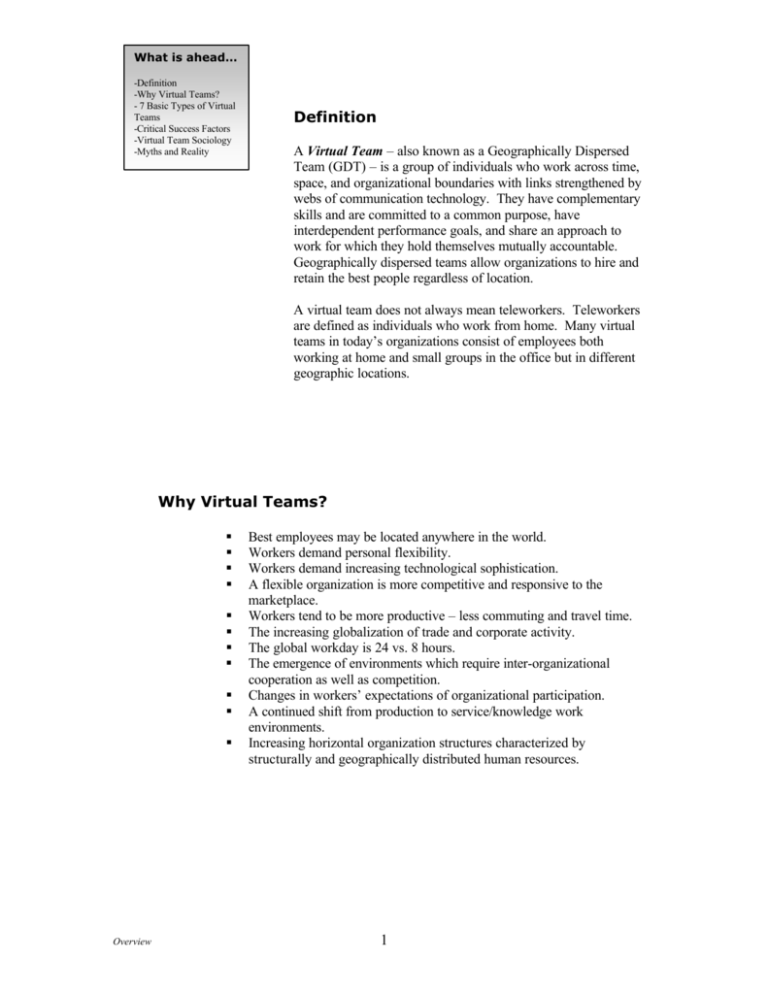
What is ahead… -Definition -Why Virtual Teams? - 7 Basic Types of Virtual Teams -Critical Success Factors -Virtual Team Sociology -Myths and Reality Definition A Virtual Team – also known as a Geographically Dispersed Team (GDT) – is a group of individuals who work across time, space, and organizational boundaries with links strengthened by webs of communication technology. They have complementary skills and are committed to a common purpose, have interdependent performance goals, and share an approach to work for which they hold themselves mutually accountable. Geographically dispersed teams allow organizations to hire and retain the best people regardless of location. A virtual team does not always mean teleworkers. Teleworkers are defined as individuals who work from home. Many virtual teams in today’s organizations consist of employees both working at home and small groups in the office but in different geographic locations. Why Virtual Teams? § § § § § § § § § § § Overview Best employees may be located anywhere in the world. Workers demand personal flexibility. Workers demand increasing technological sophistication. A flexible organization is more competitive and responsive to the marketplace. Workers tend to be more productive – less commuting and travel time. The increasing globalization of trade and corporate activity. The global workday is 24 vs. 8 hours. The emergence of environments which require inter-organizational cooperation as well as competition. Changes in workers’ expectations of organizational participation. A continued shift from production to service/knowledge work environments. Increasing horizontal organization structures characterized by structurally and geographically distributed human resources. 1 7 Basic Types of Virtual Teams Networked Teams consist of individuals who collaborate to achieve a common goal or purpose; membership is frequently diffuse and fluid. Parallel Teams work in short term to develop recommendations for an improvement in a process or system; has a distinct membership. Project or Product-Development Teams conduct projects for users or customers for a defined period of time. Tasks are usually nonroutine, and the results are specific and measurable; team has decisionmaking authority. Work or Production Teams perform regular and ongoing work usually in one function; clearly defined membership. Service Teams support customers or the internal organization in typically a service/technical support role around the clock. Management Teams work collaboratively on a daily basis within a functional division of a corporation. Action Teams offer immediate responses activated in (typically) emergency situations. Overview 2 Critical Success Factors of Virtual Teams Overview § The existence of availability standards. § Ample resources to buy and support state-of-the-art reliable communication and collaboration tools for all team members. § The existence of corporate memory systems such as lessons learned databases. § The existence of written goals, objectives, project specifications, and performance metrics; results orientation. § Managers and team members with a better-than-average ability to accurately estimate. § A lower-than-normal ration of pushed to pulled information. § Team communication is prioritized by the sender. § Human resource policies, reward/recognition systems as well as career development systems address the unique needs of virtual workers. § Good access to technical training and information on how to work across cultures. § Training methods accommodate continual and just-in-time learning. § There are standard and agreed on technical and “soft” team processes. § A “high trust” culture; teamwork and collaboration are the norm. § Leaders set high performance expectations; model behaviors such as working across boundaries and using technology effectively. § Team leaders and members exhibit competence in working in virtual environments. 3 Virtual Team Sociology Within the virtual connection is an opportunity for efficiency and team synergy unrealized in traditional teams and worker interaction. The realization of these possible outcomes is reliant upon the development of new team sociology inclusive of all virtual team members with their varying geographies and cultures; including contingent workers from outside the immediate organization. Building blocks of the “new” sociology: § § § § § § § § Overview Team members have to adopt and adapt to new technologies. Members must be more adaptive – “resilient” to a changing variety of assignments and tasks during the life of any particular team. Team membership more dynamic with changing tasks and responsibilities. Roles will be more dynamic because virtual teams are more flexible regarding organizational responses to market needs. Members are required to have superior team participation skills; team membership is fluid requiring team members who can quickly assimilate into the team (the responsibility for assimilation is primarily with the new member). Virtual teams will be expected to be able to repeatedly change membership without losing productivity; little time will be available for team members to learn how to work together. Technology such as intranets can streamline socialization of new members by coming up to speed quickly with archived written information, video, and audio recordings. Employees will have to learn to join teams and accept new members without the benefit of time-related socialization. Norms and role expectations must be expressed explicitly to new members who must quickly acculturate. 4 Myths and Realities What myths have been communicated about GDT’s and how do those myths compare with reality? Myth Reality Geographically dispersed teams are not as effective as traditional teams where everyone is located in the same place. 2. Co-located teams are always preferable. 1. GDT’s can match or exceed the performance of other teams for some tasks. They provide an advantage in some areas. Some co-located teams, when brainstorming, lock in on a single idea too early. This happens less frequently with a GDT. 1. 3. Team dynamics are the same. 4. Team members cannot develop trust. 5. There is no accountability. 2. Face to face interaction is not always the most effective approach. When there are cultural or personal differences electronic communication may be more effective. 3. Research has shown that GDT’s develop differently than co-located teams and therefore have different dynamics. (Interventions and/or team building processes may need to be different for GDT’s versus co-located teams.) 4. Trust can develop just as quickly when there is high focus on communication and interaction, regardless of co-location or dispersion. The team should define “trust” and the behaviors it would take to build it. 5. Accountability should be based on measurable outcomes. This means shifting to a resultsoriented paradigm. Out-of-sight does not mean unaccountable. 6. GDT’s fail more often due to lack of “soft skills,” not due to lack of technology skills or function. GDT’s can use technology to enhance relationship building and speed team development. 7. Leader and members’ roles are different with GDT’s, especially concerning disciplined interaction and communication. Some GDT leaders indicate they spend twice as much phone time with a GDT as with a co-located team. The increased time, especially in the initial project phase, is needed to establish relationships. When things go wrong it’s because of technology. 7. There is no difference in roles when comparing a GDT to a virtual or co-located team. 6. Overview 5


